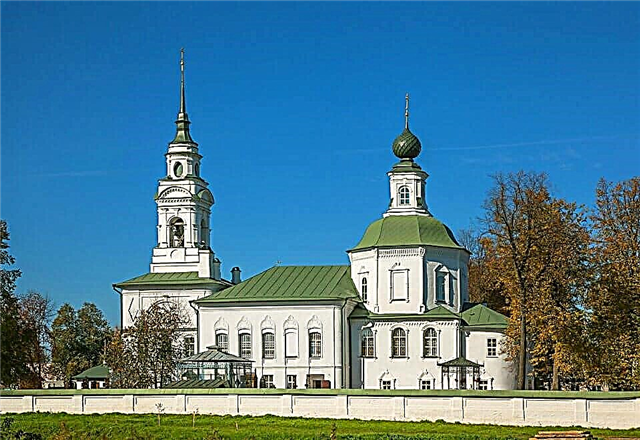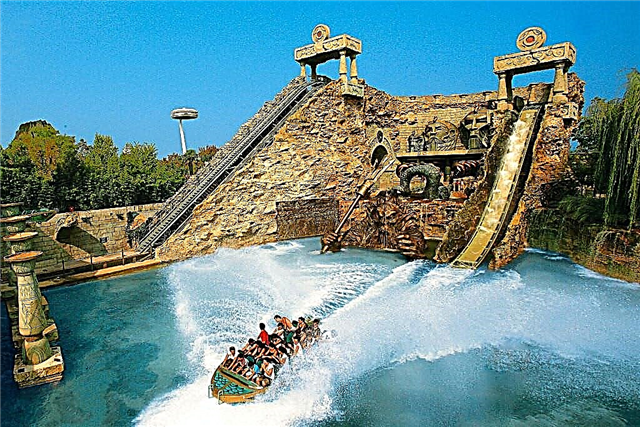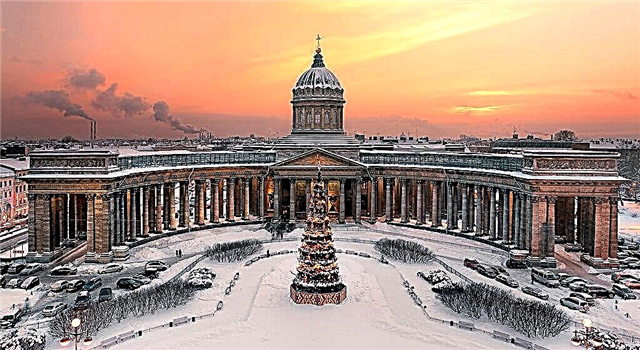There are many holy places, monuments in Russia, which reflect the long-suffering history of the country, the spiritual and heroic deeds of the people, the great leaders of the state and the church. But the Kazan Cathedral in St. Petersburg, which became an important milestone in the development of the European style in Russian architecture, has a special sacred significance among them.
Kazan icon - a symbol of protection in war

Its creation is associated with the main shrine of Russia - the icon of the Kazan Mother of God, whose appearance to the world can only be called a real miracle. The Russian soldiers overshadowed by its holy image performed many military and civil feats, among which the most important of them was the liberation of the country from the Poles in the 16th century. It was in front of the face of the Kazan Mother of God that the militia prayed before the attack on besieged Moscow, a procession of the cross took place with her in October 1612. The role of the icon in the victory over the Swedes in the Battle of Poltava (1609) and at Vyazma (1812) in the war with the French is great.
Construction history
A memorial plaque on the wall of the cathedral announces the beginning of the construction of the temple at the behest of Paul I in 1801 instead of the crumbling Church of the Nativity of the Virgin. Eminent European architects took part in the competition for the projects of the future temple, but the designs of the talented nugget architect Voronikhin, who did not participate in the competition, and was recommended by Count Stroganov, were taken as the basis. The laying of the first stone took place after the tragic death of Paul the 1st on September 8, 1801 in a solemn atmosphere.
Cathedral - the embodiment of sacred memory
It took 10 years (1801-1811) to build a significant shrine in the northern capital. Almost 5 million rubles were spent on the creation of an architectural masterpiece. The former serf of the Counts Stroganovs, the architect Voronikhin, who brilliantly implemented the emperor's idea, was awarded the honorary order of St. Vladimir. After the consecration of the Kazan Cathedral (September 15, 1811), the old church was demolished, and the new church became an object of prayerful worship of the people and a kind of monument to the military victories of Russia.
Architecture and interior decoration

The unsurpassed masterpiece of architecture is made in the Empire style and repeated in many features the famous Roman Cathedral of St. Peter, as Paul wanted 1. The shape of the temple embodied the forms of Roman basilicas and Orthodox domed-cross churches. The grandiose building of the cathedral, made of Pudozh stone (lime tuff), in the form of an elongated 4-pointed Latin cross in the center is crowned with a slender domed tower. The majestic facade colonnade repeats the architectural style of the Roman sanctuary. Outside, the facade of the temple is decorated with bronze statues of Orthodox saints and graceful bas-reliefs. The northern entrance (gate), designed like the "Paradise Doors" of the Florentine Cathedral, is made of bronze.
The internal structure also corresponds to the parameters and forms of the Roman basilica: 4 rows of monolithic Corinthian granite columns divide the space into 3 naves (corridors). The splendor of the interiors, decorated with domestic natural stones, amazes the imagination. Decorators and sculptors (Pimenov, Martos, Demut), according to Voronikhin's plan, used jasper, Karelian marble, porphyry, and lime tuff. Eminent artists Bryullov, Bruni, Borovikovsky, Kiprensky, Shebuev decorated the walls with delightful paintings on religious subjects, genuine pictorial masterpieces.
Colonnade

According to religious canons, the entrance to the cathedral should be from the west, the altar - in the east. Compliance with this rule made the temple turned sideways to Nevsky Prospect. To create the main entrance from the north, Voronikhin designed a monumental semicircular colonnade of 96 13-meter-high columns. Each Corinthian column made of lime tuff, ending with an intricate capital, individually is also an architectural masterpiece, embodying the filigree work of the builders.
What failed to translate
Voronikhin's ideas were not fully realized - the southern colonnade was not installed, but the northern one became an undoubted decoration of Nevsky Prospekt. There are no sculptures of the archangels Michael and Gabriel on the pedestals on both sides of the colonnade and the planned fence at the western entrance in front of the square. Despite this, the colonnaded structure of the Kazan Cathedral is not inferior to the grandeur and beauty of the Peter's Cathedral in Rome.
Shrines
Immediately after the Patriotic War of 1812, the Cathedral of the Kazan Mother of God, which became the first European analogue of religious sites in Russia, turned into a memorial repository of shrines and relics symbolizing important historical events of the state, the exploits of outstanding military leaders.
Monuments

Having attended a solemn prayer service in honor of the opening of the temple, MV Kutuzov immediately left here to take command of the army in the field, forever linking his fate with it. It was in the Kazan Cathedral that the body of the great field marshal was buried (June 1813). 5 years later, Alexander I issued a decree on the erection of monuments to the brilliant commanders Kutuzov and Barclay de Tolly, which they could fully execute only in 1837.
The sculptors Orlovsky, Galberg, the architect Montferand and the president of the Academy of Arts Olenin took part in the creation of the projects of the monuments. The best were the sketches of Orlovsky, who managed to embody in the sculptures of the commanders their significant contribution to the victory over the French, the essence of the characters of each of them and the portrait likeness. Both monuments are erected on granite pedestals, on which the names of the military leaders are "inscribed" in gold.
Sacred relics

The main shrine not only of the Kazan Cathedral, but of the entire Russian people is the miraculous Kazan icon, according to legend, found by 8-year-old Matryona in the ground under the burnt house. The Mother of God, who appeared to her in a dream, informed the girl about the location of the icon, which was later immortalized by the monastery. In addition to the Kazan icon, the icons of Nicholas the Wonderworker, the Savior, the Resurrection of Christ with a particle of the Lord's Sepulcher are worshiped in the cathedral.
Behind a low bronze fence, decorated with gilded wreaths, posts and corner posts in the form of cannon barrels is the sacred grave of Kutuzov. It is surrounded by the trophies won, symbolizing the victory of the Russians over the French and the liberation of Europe: Napoleon's marshal's baton, banners and standards, keys to European cities and fortresses.
Schedule of services

Kazan Cathedral - a place of spiritual cleansing, a meeting place with its shrines - is always filled with people who come to divine services that take place every day. The cathedral opens on weekdays at 7 am, on Sundays and holidays at 6.30.
Divine services on weekdays
- First (Divine) Liturgy - 07.00. Confession starts at 7.30.
- Second (Divine) Liturgy - 10.00. Confession (beginning) - 10.30.
- Evening service - 18.00.
Sundays and holidays
- First Liturgy - 7.00. Confession (beginning) - 7.30.
- Second Liturgy - 10.00. The beginning of the confession is 9.30.
- Evening service - 18.00.
Every day in the cathedral, between liturgies, solemn rites of baptism and weddings are held. Prayers are performed, memorial services are served by prior arrangement.
Sunday school for children and adults

Kazan Cathedral is a center of religious education, where Sunday schools for children and adults are organized. The adult education course is 3 years old, but you can become a student at any time. The teaching is conducted by highly erudite clergy in the form of live dialogues, scientific and educational lectures on the main issues of Orthodoxy.The program includes an acquaintance with the basics of the Law of God, the Catechism, the Old and New Testaments, the history of the Russian Orthodox Church, etc.
Classes: on Saturdays (September-May), 16.00-18.00.
Sunday school program for children
Pupils of children's Sunday school are divided into 3 age groups: junior (5-7 years old), middle (8-11), senior (12-17). The program includes the study of the Law of God (the basis of moral education), teaching church singing (spiritual and aesthetic education). Children have the opportunity to show their talents in singing, artistic visual arts, participate in various concerts, festive events, make pilgrimages to holy places. A Sunday liturgy is organized for the students every month.
Timetable of classes:
- Sunday - from 12.00 to 15.30
- Tuesday - 1630 - vocal lessons (individual)
- Saturday - art classes - 15.30, altar work (boys) - 17.00
Kazan Cathedral Youth Club
In our pragmatic, rather cynical time, it is not easy for young people to decide on moral guidelines, to find the right path in life. The youth club of the Kazan Cathedral unites seeking, caring Orthodox youth, striving to find answers to pressing questions of life in the process of communication between themselves and representatives of the church.
Organization of club activities
The club meeting program includes the following activities:
- discussion discussions of various topics, lectures
- meetings with extraordinary people, interesting contemporaries
- presentation of problem films followed by discussion
- volunteer raids, pilgrimage trips
- theological enlightenment
- participation in Orthodox holidays
Working hours

Kazan Cathedral, as the guardian of the main shrine of the Russian people, gives every person who wants to worship the icon of the Kazan Mother of God the opportunity to do it any day.
It is open to the public:
- On weekdays - from 7 am to 8 pm
- Sundays and public holidays - 6.30 am to 8 pm (end of evening service)
Where is it located and how to get there
Kazan Cathedral is located at: St. Petersburg, Nevsky Prospect, 25.
You can get to the cathedral by metro, from the station "Nevsky Prospekt" or "Gostiny Dvor". Get off at the Griboyedov Canal stop, where the cathedral is located on the opposite side. You can also get there by public land transport: trolleybus N 17, route taxi N 306, bus N 100.










